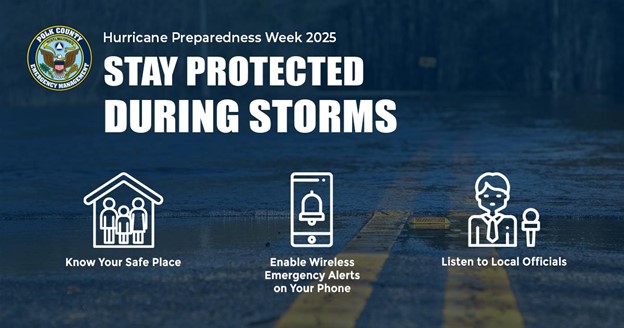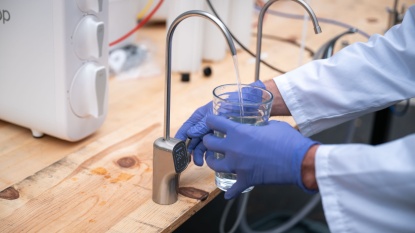Producing Safe Water for Polk County – Polk County Government

Report on Polk County Utilities’ Water Management and Contribution to Sustainable Development Goals
Operational Framework and Alignment with SDG 6
Polk County Utilities (PCU) conducts continuous water quality monitoring, aligning its daily operations with the United Nations Sustainable Development Goal 6 (SDG 6), which ensures the availability and sustainable management of water and sanitation for all. The utility’s comprehensive approach supports several targets under this goal through its extensive infrastructure and production capacity.
- Infrastructure: PCU operates 27 water plants and manages over 1,000 miles of pipelines, providing essential services to unincorporated Polk County. This robust infrastructure is critical for achieving SDG 11 (Sustainable Cities and Communities) by ensuring reliable access to basic services.
- Water Production: The daily production and distribution of 19.7 million gallons of potable water directly addresses SDG Target 6.1, aiming for universal and equitable access to safe and affordable drinking water.
- Wastewater Treatment: By collecting and treating 9.4 million gallons of wastewater each day, PCU contributes to SDG Target 6.3, which focuses on improving water quality by reducing pollution and treating wastewater.
- Water Reuse: The production and distribution of 11 million gallons of reclaimed water for irrigation purposes exemplifies progress toward SDG Target 6.4, substantially increasing water-use efficiency and ensuring sustainable freshwater withdrawals. This practice also supports SDG 12 (Responsible Consumption and Production).
Water Quality Assurance and Advanced Treatment Protocols
Professional Standards and Human Capital
The integrity of water production is maintained by a team of 15 operators licensed by the Florida Department of Environmental Protection. The requirement for extensive training, testing, and continuing education ensures a highly skilled workforce capable of managing complex water treatment systems. Operators at the Central Water Production Facility hold or are training for a Class A license, the state’s highest level of certification, underscoring a commitment to operational excellence in achieving public health and safety goals (SDG 3: Good Health and Well-being).
Advanced Treatment Processes for Water Safety (SDG 3 & SDG 6)
The Central Water Production Facility utilizes an advanced ozonation process to treat groundwater from the Upper Floridan aquifer. This technology is specifically employed to remove naturally occurring hydrogen sulfide, ensuring the water is aesthetically pleasing and safe for consumption. The treatment process is as follows:
- Pure oxygen is subjected to an electrical current to generate ozone.
- The ozone is introduced into the raw water, where it oxidizes and removes hydrogen sulfide.
- The water is then passed through Granular Activated Carbon (GAC) filters to remove any residual unwanted components.
- The final product is clean, safe drinking water that meets or exceeds regulatory standards, directly supporting SDG 3 and SDG 6.
Daily Monitoring and System Integrity
Routine Safety and Quality Control
Daily facility inspections and rigorous water quality testing are fundamental to PCU’s operations. The Central facility, which produces an average of 1.5 million gallons of water per day for approximately 15,000 customers, undergoes meticulous daily checks. Operators conduct sensory inspections to identify potential mechanical issues, leaks, or other system anomalies. Furthermore, specific chemical levels are monitored to ensure water safety throughout the distribution system.
- Disinfection: Levels of sodium hypochlorite are tested at multiple points. This disinfectant is added in the final treatment stage to eliminate germs and prevent bacterial growth within the distribution network, safeguarding public health.
- Corrosion Control: Polyphosphate levels are monitored to inhibit corrosion in pipes and plumbing fixtures. This practice protects consumers from potential contaminants like lead and extends the lifespan of the water distribution infrastructure, aligning with SDG 9 (Industry, Innovation, and Infrastructure).
Transparency and Community Engagement
Commitment to Public Reporting (SDG 6)
In line with the principles of transparency and public accountability, Polk County Utilities makes annual Consumer Confidence Reports available to the public. These reports provide detailed information on water quality for each service area, demonstrating a firm commitment to keeping customers informed and confident in the safety of their water supply. This practice reinforces the utility’s dedication to achieving the targets outlined in SDG 6.
1. Which SDGs are addressed or connected to the issues highlighted in the article?
The article on Polk County Utilities’ water monitoring and treatment processes addresses several Sustainable Development Goals (SDGs) due to its focus on providing essential public services related to water and infrastructure.
-
SDG 6: Clean Water and Sanitation
This is the most directly relevant SDG. The entire article focuses on the processes Polk County Utilities (PCU) uses to ensure the provision of safe drinking water, the treatment of wastewater, and the production of reclaimed water. It details the daily monitoring, treatment methods (ozonation, GAC filters), and disinfection to ensure water is “consistently safe and healthy to drink.”
-
SDG 9: Industry, Innovation, and Infrastructure
The article highlights the infrastructure required to deliver clean water and manage wastewater. It mentions “27 water plants,” “more than 1,000 miles of pipelines,” and the specialized “Central Water Production Facility.” This infrastructure is critical for the well-being of the community and represents the kind of resilient and sustainable systems that SDG 9 promotes.
-
SDG 11: Sustainable Cities and Communities
By providing essential services like safe drinking water and wastewater management to residents in “unincorporated Polk County” and the “greater Winter Haven area,” PCU contributes to making these communities safe, resilient, and sustainable. Access to reliable and safe water is a basic service necessary for sustainable urban and community development.
2. What specific targets under those SDGs can be identified based on the article’s content?
Based on the activities described in the article, several specific SDG targets can be identified:
-
Target 6.1: By 2030, achieve universal and equitable access to safe and affordable drinking water for all.
The article’s core theme is the provision of safe drinking water. PCU “produces and distributes 19.7 million gallons of drinkable water each day” to its customers. The detailed description of daily testing, advanced treatment processes like ozonation, and disinfection with sodium hypochlorite directly supports the goal of providing safely managed drinking water.
-
Target 6.3: By 2030, improve water quality by reducing pollution… halving the proportion of untreated wastewater and substantially increasing recycling and safe reuse globally.
PCU’s operations align with this target in two ways. First, it “collects and treats 9.4 million gallons of wastewater each day,” which directly addresses the goal of treating wastewater. Second, it “produces and distributes 11 million gallons a day of reclaimed water for irrigation,” which contributes to the goal of increasing water recycling and safe reuse.
-
Target 9.1: Develop quality, reliable, sustainable and resilient infrastructure… to support economic development and human well-being.
The article describes the physical infrastructure managed by PCU, including the 27 water plants and over 1,000 miles of pipelines. The daily maintenance routines (“listen for abnormal noises, look for leaks”) and the use of corrosion inhibitors (polyphosphates) to “extend the life of pipes and distribution systems” demonstrate a commitment to maintaining reliable and resilient infrastructure.
-
Target 11.1: By 2030, ensure access for all to adequate, safe and affordable housing and basic services.
The provision of safe water is a fundamental basic service. The article states that the Central Water Production Facility alone “serves approximately 15,000 customers.” By managing the water supply for a large residential area, PCU is directly involved in ensuring the community has access to this essential service.
3. Are there any indicators mentioned or implied in the article that can be used to measure progress towards the identified targets?
Yes, the article contains several quantitative and qualitative data points that can serve as indicators to measure progress towards the identified targets.
-
Indicator for Target 6.1 (Safely managed drinking water):
The article implies progress towards the official indicator 6.1.1 (Proportion of population using safely managed drinking water services). Specific measures mentioned include:
- The volume of safe drinking water produced: “19.7 million gallons of drinkable water each day.”
- The frequency of quality control: “Operators test samples… seven days per week.”
- Specific quality checks: Monitoring “safe levels of sodium hypochlorite” for disinfection and “polyphosphate levels” for corrosion control.
- Transparency in reporting: “Consumer confidence reports are shared on the Polk County Utilities website.”
-
Indicator for Target 6.3 (Wastewater treatment and reuse):
The article provides direct data relevant to the official indicator 6.3.1 (Proportion of domestic and industrial wastewater flows safely treated). The specific measures are:
- The volume of wastewater treated: “Collects and treats 9.4 million gallons of wastewater each day.”
- The volume of water reused: “Produces and distributes 11 million gallons a day of reclaimed water for irrigation.”
-
Indicator for Target 9.1 and 11.1 (Infrastructure and basic services):
While not a formal UN indicator, the article provides data that can be used to measure the scale and reliability of the service infrastructure:
- The extent of the infrastructure: “27 water plants” and “more than 1,000 miles of pipelines.”
- The number of people served: The Central facility serves “approximately 15,000 customers.”
- The qualifications of staff: The presence of licensed operators, including those with the “class A license,” indicates a commitment to quality and reliability in service delivery.
4. SDGs, Targets, and Indicators Table
| SDGs | Targets | Indicators Identified in the Article |
|---|---|---|
| SDG 6: Clean Water and Sanitation | 6.1: Achieve universal and equitable access to safe and affordable drinking water for all. |
|
| SDG 6: Clean Water and Sanitation | 6.3: Improve water quality by reducing pollution, halving the proportion of untreated wastewater, and increasing recycling. |
|
| SDG 9: Industry, Innovation, and Infrastructure | 9.1: Develop quality, reliable, sustainable and resilient infrastructure. |
|
| SDG 11: Sustainable Cities and Communities | 11.1: Ensure access for all to adequate, safe and affordable basic services. |
|
Source: polk-county.net

What is Your Reaction?
 Like
0
Like
0
 Dislike
0
Dislike
0
 Love
0
Love
0
 Funny
0
Funny
0
 Angry
0
Angry
0
 Sad
0
Sad
0
 Wow
0
Wow
0









































































